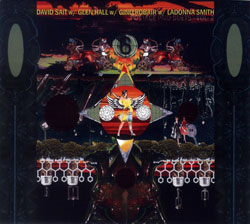
The harmonic structures, emphasis on sound � not function � and otherwise essence of Oriental musics is tough to market to your average Yo-Yo Ma fan; sadly, most East to West conversions end up smoothed over with equal tempered placidity. Composer T�ru Takemitsu, on the other hand, believed that the coupling of these disparate aesthetics should vigorously emphasize differences and contradictions, as demonstrated in his November Steps (for orchestra, biwa and shakuhachi). Toronto native David Sait is somewhere in-between these two...
Okay, he's in his own world. An improviser and disciple of the 21-stringed Guzheng (Chinese zither, a parent of the koto), he persists in a relentless expansion of the instrument's vernacular by "rarely (tuning) it the same way twice, exploring the world of random, alternative tunings this grand instrument conveniently lends itself well to". The results range from dynamically cacophonous to organic to spacious to outright screwed-up, Sait plucking, snapping, hammering on, muting, buzzing, detuning, rubbing, flicking and almost transmogrifying the instrument with case ownership.
Furthering this genre-bending affair, Sait pairs with a different collaborator on each of the seven works. On "Ducheng", violist/violinist/erhu player LaDonna Smith initially offers a trek on the Silk Road: fragmented, lilting melodies, sforzando dips and tender, bowed tremolo to complement Sait's idiomatic trills and tonality. Soon, however, the duo ponders "wrong" notes, passing tones, independence from one another and the timbre of their respective sound boards. Percussionist Gino Robair's contributions to "The History of Shape and Glue" wander from bowed metals to thumping "sheppard drum" (sic) to pleasingly squeaky bike horns to Philip Jeck style turntable mechanics (billed as "motors"); for "Waist Deep in Saigon", his flurry of various gongs and bells mixed into a broken Gamelan provides a splendid juxtaposition to Sait's banjo-meets-woozy-twelve-string-guitar attack. Wind player Glenn Hall's subtle bass flute work pushes Sait towards the most Pan-Asian piece of the album ("Mellifluous"), and their subsequent union on "Chimo" (Hall on soprano sax) provides the, for lack of a better term, spiritual highlight of the album. As Hall slinks along, finding purchase with tender squawks and barely audible exhales, Sait directs his focus to darker registers and ascension through bionic trills and microtonalities (the type of pitch-bending that crosses eyes and sets your soul adrift).
Comments and Feedback:
|



